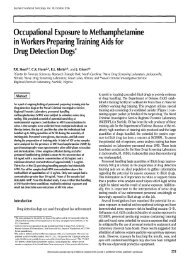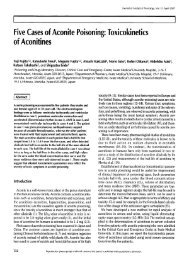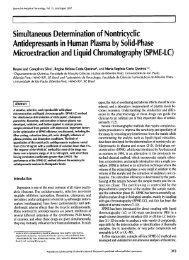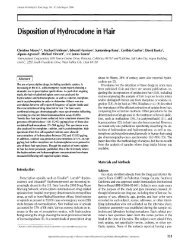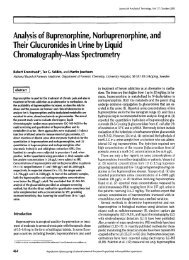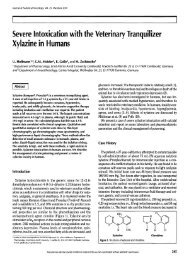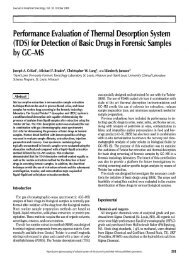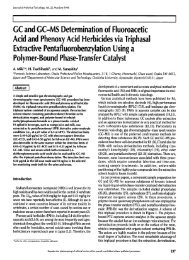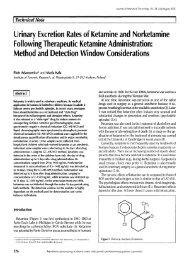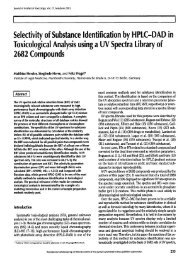Liquid Chromatography–Tandem Mass Spectrometry Detection of ...
Liquid Chromatography–Tandem Mass Spectrometry Detection of ...
Liquid Chromatography–Tandem Mass Spectrometry Detection of ...
You also want an ePaper? Increase the reach of your titles
YUMPU automatically turns print PDFs into web optimized ePapers that Google loves.
Case Report<br />
<strong>Liquid</strong> <strong>Chromatography–Tandem</strong> <strong>Mass</strong> <strong>Spectrometry</strong><br />
<strong>Detection</strong> <strong>of</strong> the Quaternary Ammonium Compound<br />
Mebezonium as an Active Ingredient in T61 ®<br />
Katrin M. Kirschbaum 1 , Wolfgang Grellner 2 , Gertrud Rochholz 3 , Frank Mussh<strong>of</strong>f 1, *, and Burkhard Madea 1<br />
1 Institute <strong>of</strong> Forensic Medicine, University <strong>of</strong> Bonn, Bonn, Germany; 2 Institute <strong>of</strong> Forensic Medicine, University <strong>of</strong> Göttingen,<br />
Göttingen, Germany; and 3 Institute <strong>of</strong> Forensic Medicine, University Hospital Schleswig-Holstein, Kiel, Germany<br />
Abstract<br />
Quaternary ammonium compounds pose an analytical challenge.<br />
Mebezonium, a muscle-relaxing agent contained in veterinary<br />
euthanasia solution T61, was analyzed in body fluids, organs, and<br />
injection sites <strong>of</strong> a veterinarian by liquid chromatography–tandem<br />
mass spectrometry (LC–MS–MS) method. Additionally,<br />
embutramide and tetracaine, which are two other active<br />
ingredients contained in T61, methadone, xylazine, and analgesics<br />
were detected by LC–MS–MS and high-performance liquid<br />
chromatography–ultraviolet detection methods. For detection <strong>of</strong><br />
mebezonium a solid-phase extraction (SPE) combined with ionpairing<br />
reagent heptafluorobutyric acid was developed. Separation<br />
was achieved on Phenomenex Synergi Hydro RP C 18 column<br />
combined with ammonium formate buffer and acetonitrile<br />
(pH 3.5). To enrich other drugs, liquid–liquid extraction procedures<br />
were used. Most <strong>of</strong> these drugs were separated on a Restek Allure<br />
PFP Propyl column using the mentioned mobile phase.<br />
Mebezonium and embutramide were detected in femoral vein<br />
serum in concentrations <strong>of</strong> 10.9 and 2.0 mg/L, respectively. The<br />
concentration <strong>of</strong> xylazine and methadone in serum was 2.0 and<br />
0.4 mg/L, respectively. The LC–MS–MS method with SPE combined<br />
with an ion-pairing reagent allowed the quantitation <strong>of</strong><br />
mebezonium. Methadone was detected in toxic concentrations and<br />
was, in combination with xylazine and T61, considered to be the<br />
cause <strong>of</strong> death.<br />
Introduction<br />
Quaternary ammonium compounds that might be used as<br />
muscle relaxants are analytical challenges. Because <strong>of</strong> a<br />
missing chromophore, thermal instability, and hydrophilicity<br />
* Author to whom correspondence should be addressed: Pr<strong>of</strong>. Dr. Frank Mussh<strong>of</strong>f,<br />
Institute <strong>of</strong> Forensic Medicine, University <strong>of</strong> Bonn, Stiftsplatz 12, 53111 Bonn, Germany.<br />
Email: F.Mussh<strong>of</strong>f@uni-bonn.de.<br />
124<br />
due to a permanent positive charge, they are difficult to extract<br />
and to analyze (1,2).<br />
Several methods for determination <strong>of</strong> quaternary ammonium<br />
compounds are described in the literature. Solid-phase<br />
extraction (SPE) with C 18- (3,4) or CBA-columns (5), partly in<br />
combination with an ion pair reagent like heptafluoric acid<br />
(HFBA), are used for screening or quantitative analysis. One<br />
method describes a fluid–fluid extraction with addition <strong>of</strong><br />
potassium iodide (6) followed by liquid chromatography–mass<br />
spectrometry (LC–MS) analysis.<br />
The quaternary ammonium compound mebezonium iodide<br />
(Figure 1) is a competitive inhibitor <strong>of</strong> acetylcholine at nicotinergic<br />
acetylcholine receptors (7). It is an active substance in<br />
T61, a euthanasia drug. Embutramide and tetracaine are also<br />
active substances <strong>of</strong> the drug. Embutramide has narcotic properties,<br />
it induces deep anesthesia and an inhibition <strong>of</strong> the respiratory<br />
center located in the brainstem. Tetracaine is a local<br />
anesthetic substance and decreases painful reactions at injection<br />
sites (7).<br />
In the literature, few cases <strong>of</strong> suicides or homicides involving<br />
the use <strong>of</strong> T61 are described (7–17). In most cases, embutramide,<br />
which is exclusively used in T61, was the only substance<br />
analyzed because <strong>of</strong> the difficulties with the analysis <strong>of</strong><br />
mebezonium. Embutramide can be analyzed by thin-layer<br />
liquid chromatography followed by ultraviolet (UV) detection<br />
Reproduction (photocopying) <strong>of</strong> editorial content <strong>of</strong> this journal is prohibited without publisher’s permission.<br />
Journal <strong>of</strong> Analytical Toxicology, Vol. 35, March 2011<br />
Figure 1. The chemical structure <strong>of</strong> mebezonium iodide.
Journal <strong>of</strong> Analytical Toxicology, Vol. 35, March 2011<br />
(8), by gas chromatography (GC)–MS (9,14,18,19) or by a nitrogen-phosphorus<br />
detector (20), by high-performance liquid<br />
chromatography (HPLC) followed by UV-spectroscopy (15,19),<br />
or by MS (21). In only two cases <strong>of</strong> human intoxication in<br />
which embutramide was analyzed were mebezonium (8) or<br />
mebezonium and tetracaine (14) analyzed, too.<br />
In one case, the quaternary ammonium compound was<br />
quantified by thin-layer LC and UV detection (8). Kintz et al.<br />
(14) used liquid–liquid extraction combined with potassium iodide<br />
for extraction followed by LC–MS analysis.<br />
In a case <strong>of</strong> suicide and fatal intoxication <strong>of</strong> a former veterinarian<br />
(22), we analyzed each active ingredient <strong>of</strong> T61. The<br />
man had suffered from metastatic intestine cancer, and shortly<br />
before his death, a tumor at the base <strong>of</strong> his skull was diagnosed.<br />
Several other veterinary drugs and analgesics were analyzed in<br />
blood, urine, cerebrospinal fluid, brain, muscle, kidney, liver,<br />
and injection sites as well as in a syringe and in drug bottles<br />
found at the death scene. The former veterinarian not only injected<br />
T61 but also xylazine, an α 2-adrenergic agonist used as<br />
a sedative, analgesic, and muscle relaxant in animals (23), and<br />
L-Polamivet ® , with levomethadone as active ingredient which<br />
is used as analgesic.<br />
Materials and Methods<br />
Solutions and buffers were purchased in HPLC grade from<br />
Merck (Darmstadt, Germany). Deuterated internal standards<br />
were obtained from Cerilliant (Round Rock, TX). All other<br />
substances were obtained from local pharmacies.<br />
The quantitative analysis <strong>of</strong> most substances was performed<br />
by LC–MS–MS systems. If available, deuterated internal standards<br />
were used as analyte to internal standard concentration<br />
for quantitation. Calibration was made by five or six concentrations<br />
<strong>of</strong> spiked and extracted serum control samples. Concentrations<br />
were in accordance with therapeutic and toxic<br />
levels <strong>of</strong> each substance. The analgetics ibupr<strong>of</strong>en and paracetamol<br />
were analyzed by routine methods using HPLC–DAD.<br />
<strong>Detection</strong> <strong>of</strong> mebezonium<br />
A recently published method for detection <strong>of</strong> succinylcholine<br />
and succinylmonocholine (24) was modified and used for the<br />
analysis <strong>of</strong> mebezonium. Samples <strong>of</strong> 0.5 and 1 mL were extracted<br />
using 55-µm strata-C 18 cartridges (200 mg/3 mL, Phenomenex,<br />
Aschaffenburg, Germany) with addition <strong>of</strong> HFBA as<br />
an ion pair reagent and succinylcholine-d 18 as the internal<br />
standard. The LC–MS–MS system includes an API 2000 triplequadrupole<br />
MS and an Agilent 1100 HPLC-system. Analytes<br />
were separated on a Synergi Hydro-RP C 18 column (150 × 2<br />
mm, 4 µm, Phenomenex) using gradient elution with ammonium<br />
formate buffer (5 mM, pH 3.5) and acetonitrile [eluent A<br />
90:10 (v/v); eluent B 10:90 (v/v)]. Positive electrospray ionization<br />
was used and analysis was performed by MRM, using the<br />
precursor ion for mebezonium at m/z 148 and the product<br />
ions at m/z 236 (target) and 60 (qualifier) and for succinylcholine-d<br />
18 as internal standard using precursor ion at m/z 154<br />
and product ion at m/z 120.<br />
<strong>Detection</strong> <strong>of</strong> embutramide, xylazine, tramadol,<br />
tilidine, nortilidine, bisnortilidine, 4-aminoantipyrine,<br />
and 4-methylaminoantipyrine<br />
To analyze embutramide, xylazine, tramadol, tilidine, bisnortilidine,<br />
4-aminoantipyrine, and 4-methylaminoantipyrine,<br />
we precipitated 100 µL <strong>of</strong> blood, urine, and cerebrospinal fluid<br />
and 100 µL <strong>of</strong> tissue homogenized with water (1:10, m/m)<br />
with 100 µL <strong>of</strong> acetonitrile as sample preparation. The supernatant<br />
was injected directly. Chromatographic separation was<br />
perfomed by an Agilent 1100 HPLC-system (Waldbronn, Germany)<br />
with an Allure-PFP-Propyl column (50 × 2.1 mm, 5<br />
µm, Restek, Bad Homburg, Germany) in combination with<br />
ammonium formate buffer (5 mM, pH 3.5) and acetonitrile<br />
[eluent A 90:10 (v/v); eluent B 10:90 (v/v)] was used with a total<br />
run time <strong>of</strong> 15 min. For MS detection, API 2000 triplequadrupole<br />
MS (Applied Biosystems, Darmstadt, Germany)<br />
with ESI in positive mode was used. Analysis was performed by<br />
multi-reaction monitoring (MRM) using a precursor ion and<br />
two product ions for each substance: embutramide m/z 294 →<br />
121 (T) and m/z 294 → 91 (Q), xylazine m/z 221 → 164 (T) and<br />
m/z 221 → 90 (Q), tramadol m/z 264 → 58 (T) and m/z 264 →<br />
115 (Q), tilidine m/z 274 → 155 (T) and m/z 274 → 77 (Q), nortilidine<br />
m/z 260 → 155 (T) and m/z 260 → 77 (Q), bisnortilidine<br />
m/z 246 → 155 (T) and m/z 246 → 229 (Q), 4-aminoantipyrine<br />
m/z 204 → 56 (T) and m/z 204 → 94 (Q),<br />
4-methylaminoantipyrine m/z 218 → 56 (T) and m/z 218 → 97<br />
(Q).<br />
<strong>Detection</strong> <strong>of</strong> codeine, methadone, and EDDP<br />
Codeine, methadone, and EDDP were analyzed according to<br />
a validated method by Kirschbaum et al. (25). After the addition<br />
<strong>of</strong> 10 µL <strong>of</strong> an internal standard solution (codeine-d 3,<br />
methadone-d 3, and EDDP-d 3) and 150 µL buffer pH 11 to 0.5<br />
mL sample the mixture was extracted with 2 mL <strong>of</strong> n-butyl<br />
chloride. Then the organic layer was evaporated to dryness<br />
and reconstituted with 100 µL <strong>of</strong> eluent A. Chromatographic<br />
separation was performed on an Allure-PFP-propyl column<br />
(50 × 2.1 mm, 5 µm) at 40°C in combination with the eluents<br />
described. The LC–MS–MS system includes an LC-20 prominence<br />
HPLC system (Shimadzu) and an API 4000 MS (Applied<br />
Biosystems). Positive electrospray ionization was used and<br />
analysis was performed by MRM using the precursor ion and<br />
two product ions for each substance: codeine m/z 300 → 152<br />
(T) and m/z 300 → 115 (Q), methadone m/z 310 → 265 (T) and<br />
m/z 310 → 105 (Q), and EDDP m/z 279 → 235 (T) and m/z 279<br />
→ 250 (Q).<br />
Results and Discussion<br />
For the quantitative detection <strong>of</strong> the mebezonium ion an established<br />
and validated method for succinylcholine and succinylmonocholine<br />
using SPME with HFBA as an ion pair<br />
reagent was suitable. The selectivity for mebezonium was tested<br />
with blank serum and showed no interfering peaks. Precision<br />
was 13.9% for 500 µg/L (n = 6) and 8.6% for 2500 µg/L (n = 6).<br />
The accuracy was 101.2% and 99.3% (n = 6), respectively. Sam-<br />
125
ples that were extracted using C 18 cartridges showed two peaks<br />
with retention times <strong>of</strong> 2.8 and 3.1 min (Figure 2) when using<br />
a gradient starting with 80% eluent A for the first 3 min decreasing<br />
to 20% eluent A for the following 2 min. When starting<br />
the gradient with 95% eluent A, the retention time changed to<br />
1.2 min and only one peak was observed with an identical mass<br />
spectrum <strong>of</strong> the product ion scan (Figure 3). The extraction<br />
Figure 2. Product ion scan <strong>of</strong> an extracted serum sample spiked with 5 mg/L mebezonium and mass<br />
spectra <strong>of</strong> the two peaks (RT 2.8 and 3.1 min) using extraction with C 18 cartridges and gradient starting<br />
with 80% eluent A.<br />
Figure 3. Product ion scan <strong>of</strong> an extracted serum sample spiked with 5 mg/L mebezonium and mass spectrum<br />
<strong>of</strong> one peak (RT 1.2 min) using extraction with C 18 cartridges and gradient starting with 95% eluent<br />
A.<br />
126<br />
Journal <strong>of</strong> Analytical Toxicology, Vol. 35, March 2011<br />
method with C 18 cartridges was applied to standard solutions,<br />
extracted calibration samples and real samples. Only one peak<br />
was detected after extraction with STRATA-XC cartridges using<br />
a gradient starting with 80% eluent A. This peak was much<br />
lower in its intensity. <strong>Mass</strong> spectra <strong>of</strong> the product ion scans<br />
showed that there is the identical substance after extraction<br />
with C 18 cartridges and a gradient starting with 80% eluent A in<br />
both peaks (Figure 2). Therefore, the sum<br />
<strong>of</strong> both peaks was used for quantitation.<br />
Clustering <strong>of</strong> mebezonium with a variable<br />
number <strong>of</strong> iodide ions and subsequent insource<br />
fragmentation might be an explanation<br />
for occurrence <strong>of</strong> two peaks. In<br />
contrast to Kintz et al. (14), who quantitated<br />
a specific ion <strong>of</strong> m/z 294, we used the<br />
transition <strong>of</strong> m/z 148 → 236 <strong>of</strong> the double<br />
charged molecule.<br />
Additional substances could be quantitated<br />
by few methods and simple extraction<br />
procedures or precipitation. The especially<br />
low sample volume needed for<br />
each method enabled the quantitation <strong>of</strong><br />
all analytes. Extracted calibration curves<br />
covered the range <strong>of</strong> the detected concentrations.<br />
They were linear and revealed<br />
correlation coefficients <strong>of</strong> r > 0.995. At<br />
the lowest calibrator point, the signal-tonoise<br />
ratio was always higher than 10 for<br />
all target compounds.<br />
Embutramide, mebezonium, tetracain,<br />
xylazine, and methadone were detected in<br />
fluids and tissues <strong>of</strong> the deceased veterinarian<br />
(Table I). These substances were<br />
also found in a syringe and drug-containing<br />
bottles found at the crime scene,<br />
as well as in high concentrations in injection<br />
sites <strong>of</strong> a port located near the clavicula<br />
and in the hypogastric region. Concentrations<br />
<strong>of</strong> embutramide and<br />
mebezonium <strong>of</strong> 2.0 and 10.9 mg/L, respectively,<br />
in vein blood serum and 1.3<br />
and 0.5 mg/L, respectively, in urine are<br />
comparable to concentrations measured<br />
in the case R.C. reported by Bertol et al.<br />
(8). They detected concentrations <strong>of</strong> 3.0<br />
mg/L embutramide and 4.5 mg/L mebezonium<br />
iodide in blood and 2.0 mg/L embutramide<br />
and 0.8 mg/L mebezonium iodide<br />
in urine in an 80-year-old retired<br />
veterinarian who had injected T61 intramuscularly.<br />
Different fatal cases showed<br />
much higher concentrations <strong>of</strong> embutramide<br />
with 12.1 and 15.5 mg/L [cases<br />
B.L. and D.C.S. (8)], 31.0 mg/L (9), 43.0<br />
mg/L (14), and 90.0 mg/L (15). In those<br />
cases the drug had been administered either<br />
intravenously or orally.<br />
The concentration <strong>of</strong> xylazine in serum
Journal <strong>of</strong> Analytical Toxicology, Vol. 35, March 2011<br />
Table I. Concentrations <strong>of</strong> the Veterinary Drugs and Analgesics (µg/L) in Different Fluids and Tissues<br />
Serum Serum Cerebrospinal<br />
Analyte Urine Heart Left Vein* Fluid Brain Muscle Kidney Liver<br />
Mebezonium 516 44,500 10,900 4660 442 3050 31,100 17,700<br />
Embutramide 1280 6020 2020 1180 12,800 8140 34,600 48,100<br />
Tetracaine 36.5 12.5 † n.p. ‡ n.p. n.p. n.p. n.p. 22.1<br />
Xylazine 4630 1250 2030 582 4220 1360 12,200 9670<br />
Tilidine 71.3 31.5 23.3 22.4 20.3 322 338 246<br />
Nortilidine 73.0 15.5 11.1 11.9 8.29 88.1 129 194<br />
Bisnortilidine 2180 30.1 27.7 22.2 162 89.4 1580 431<br />
Codeine 90.9 < 30 < 30 < 30 < 30 < 30 < 30 < 30<br />
Tramadol 144 1.83 1.48 2.17 n.p. n.p. 22.7 4.75<br />
Methadone 601 171 442 54 777 442 3680 1430<br />
EDDP < 10 < 10 < 10 < 10 < 10 < 10 < 10 12<br />
4-Aminoantipyrine 6900 1540 1880 1060 2630 3570 3600 5160<br />
4-Methylaminoantipyrine 3350 1970 1940 1360 2830 2920 2500 6650<br />
Metamizole (sum) 10,250 3510 3820 2420 5460 6490 6100 11,810<br />
Ibupr<strong>of</strong>en 3040 6680 n.t. n.t. n.p. n.p. n.p. n.p.<br />
Paracetamol traces n.p. n.p. n.p. n.p. n.p. n.p. n.p.<br />
* Femoral vein.<br />
† Whole blood.<br />
‡ Abbreviations: n.t., not tested and n.p., not present.<br />
with 2.0 mg/L in the presented case was lower than in a case <strong>of</strong><br />
a non-fatal suicide attempt with 4.6 mg/L in serum (26).<br />
Capraro et al. (27) reported a concentration <strong>of</strong> 0.5 mg/L in<br />
blood 2 h after inhalation. In both cases, the injured persons received<br />
treatment in an intensive care unit.<br />
In the presented case serum concentration <strong>of</strong> methadone<br />
was with 442 µg/L in the range <strong>of</strong> a potentially lethal dose and<br />
can, in combination with xylazine and T61, be considered as<br />
cause <strong>of</strong> death.<br />
The analgesics tramadol, tilidine and its metabolites, metamizole<br />
(detected as 4-aminoantipyrine and 4-methylaminoantipyrine),<br />
and ibupr<strong>of</strong>en were found in concentrations below<br />
their therapeutic ranges (Table I). Codeine and paracetamol<br />
could also be detected in urine but not at injection sites. They<br />
were probably taken as pain treatment for an existing tumor disease.<br />
References<br />
1. J.J. Roy and F. Varin. Physicochemical properties <strong>of</strong> neuromuscular<br />
blocking agents and their impact on the pharmacokinetic-pharmacodynamic<br />
relationship. Br. J. Anaesth. 93: 241–248 (2004).<br />
2. H. Tsutsumi, M. Nishikawa, M. Katagi, and H. Tsuchihashi. Adsorption<br />
and stability <strong>of</strong> suxamethonium and its major hydrolysis<br />
product succinylmonocholine using liquid chromatography–electrospray<br />
ionization mass spectrometry. J. Health Sci. 49: 285–<br />
290 (2003).<br />
3. C.H. Kerskes, K.J. Lusth<strong>of</strong>, P.G. Zweipfenning, and J.P. Franke. The<br />
detection and identification <strong>of</strong> quaternary nitrogen muscle relaxants<br />
in biological fluids and tissues by ion-trap LC–ESI-MS.<br />
J. Anal. Toxicol. 26: 29–34 (2002).<br />
4. K.D. Ballard, W.E. Vickery, L.T. Nguyen, F.X. Diamond, and<br />
F. Rieders. An analytical strategy for quaternary ammonium neuromuscular<br />
blocking agents in a forensic setting using LC–MS/MS<br />
on a tandem quadrupole/time-<strong>of</strong>-flight instrument. J. Am. Soc.<br />
<strong>Mass</strong> Spectrom. 17: 1456–1468 (2006).<br />
5. M.M. Ariffin and R.A. Anderson. LC/MS/MS analysis <strong>of</strong> quaternary<br />
ammonium drugs and herbicides in whole blood. J. Chromatogr.<br />
B Analyt. Technol. Biomed. Life Sci. 842: 91–97 (2006).<br />
6. V. Cirimele, M. Villain, G. Pépin, B. Ludes, and P. Kintz. Screening<br />
procedure for eight quaternary nitrogen muscle relaxants in blood<br />
by high-performance liquid chromatography–electrospray ionization<br />
mass spectrometry. J. Chromatogr. B Analyt. Technol.<br />
Biomed. Life Sci. 789: 107–113 (2003).<br />
7. W.H. Cordell, S.C. Curry, R.B. Furbee, and D.L. Mitchell-Flynn.<br />
Veterinary euthanasia drugs as suicide agents. Ann. Emerg. Med.<br />
15: 939–943 (1986).<br />
8. E. Bertol, F. Mari, and A. Bonelli. Analytical toxicological studies<br />
in cases <strong>of</strong> suicide by injection <strong>of</strong> Tanax, a veterinary euthanasia<br />
agent. J. Pharm. Biomed. Anal. 1: 373–377 (1983).<br />
9. R.A. Smith and D. Lewis. Suicide by ingestion <strong>of</strong> T-61. Vet. Hum.<br />
Toxicol. 31: 319–320 (1989).<br />
10. W. Buylaert, P. Calle, P. De Paepe, A. Verstraete, N. Samyn,<br />
D. Vogelaers, M. Vandenbulcke, and F. Belpaire. Hepatotoxicity<br />
<strong>of</strong> N,N-dimethylformamide (DMF) in acute poisoning with the<br />
veterinary euthanasia drug T-61. Hum. Exp. Toxicol. 15: 607–611<br />
(1996).<br />
11. P. Hantson, C. Semaan, J.C. Jouret, J. Rahier, R. Lauwerys,<br />
J.P. Brunain, and P. Mahieu. Intracardiac injection <strong>of</strong> T-61, a veterinary<br />
euthanasia drug. J. Toxicol. Clin. Toxicol. 34: 235–239 (1996).<br />
127
12. F. Trevisani, M.R. Tamé, M. Bernardi, C. Tovoli, A. Gasbarrini,<br />
M. Panarelli, and G. Gasbarrini. Severe hepatic failure occurring<br />
with T61 ingestion in an attempted suicide. Early recovery with<br />
the use <strong>of</strong> intravenous infusion <strong>of</strong> reduced glutathione. Dig. Dis.<br />
Sci. 38: 752–756 (1993).<br />
13. M. Giorgi and S. Bertini. TANAX (T-61): an overview. Pharmacol.<br />
Res. 41: 379–383 (2000).<br />
14. P. Kintz, V. Cirimele, and B. Ludes. Blood investigation in a fatality<br />
involving the veterinary drug T-61. J. Anal. Toxicol. 26: 529–531<br />
(2002).<br />
15. E. Abe, M. Delamoye, B. Mathieu, M. Durigon, P. de Mazancourt,<br />
C. Advenier, and J.C. Alvarez. A rapid and sensitive high-performance<br />
liquid chromatography method for determination <strong>of</strong> embutramide<br />
(a Tanax or T61 component) in human blood with<br />
photodiode-array UV detection. J. Anal. Toxicol. 28: 118–121<br />
(2004).<br />
16. F. Anger, F. Paysant, A. Baert, F. Le Gall, M.A. Le Gueut,<br />
J.-P. Goullé, G. Lachâtre, G. Pépin, and J.-P. Anger. Suicide by injection<br />
<strong>of</strong> T-61. Ann. Toxicol. Anal. 14: 118–124 (2002).<br />
17. E. Klug. On the detection <strong>of</strong> mebezonium iodide. Fresenius Z.<br />
Anal. Chem. 329: 490 (1987).<br />
18. W.E. Braselton, J.S. Ray, M.R. Slanker, and P.C. Rumler. Determination<br />
<strong>of</strong> embutramide in mammalian tissues. Vet. Hum. Toxicol.<br />
30: 536–539 (1988).<br />
19. M. Giorgi, S. Bertini, G. Soldani, and M. Giusiani. Comparison <strong>of</strong><br />
HPLC and GC–MS methods for determination <strong>of</strong> embutramide (a<br />
component <strong>of</strong> Tanax or T-61) in biological specimens. J. Anal. Toxicol.<br />
25: 323–327 (2001).<br />
20. J.Z. Huo, J. Van Bocxlaer, W.E. Lambert, and A.P. De Leenheer.<br />
Determination <strong>of</strong> embutramide in biological matrices by gas<br />
128<br />
Journal <strong>of</strong> Analytical Toxicology, Vol. 35, March 2011<br />
chromatography with nitrogen-phosphorus detection. J. Chromatogr.<br />
B Biomed. Appl. 661: 69–74 (1994).<br />
21. M. Fidani, M.C. Gamberini, E. Pasello, F. Palazzoli, T. Dimasi, and<br />
M. Montana. Development <strong>of</strong> a liquid chromatography–tandem<br />
mass spectrometry method for an euthanasic veterinarian drug:<br />
Tanax. J. Pharm. Biomed. Anal. 48: 902–908 (2008).<br />
22. W. Grellner, G. Rochholz, K.M. Kirschbaum, B. Madea, and<br />
F. Mussh<strong>of</strong>f. Suicide with veterinary drugs: analysis—reconstruction—capacity<br />
to act. Rechtsmedizin 18: 328 (2008) (Abstract, in<br />
German).<br />
23. G. Kroneberg, A. Oberdorf, F. H<strong>of</strong>fmeister, and W. Wirth. On the<br />
pharmacology <strong>of</strong> 2-(2,6-dimethylphenylamino)-4H-5,6dihydro-1,3-thiazine<br />
(Bayer 1470), a substance inhibitory for<br />
adrenergic and cholinergic neurons. Naunyn Schmiedebergs<br />
Arch. Exp. Pathol. Pharmakol. 256: 257–280 (1967) (in German).<br />
24. U. Kuepper, F. Mussh<strong>of</strong>f, and B. Madea. A fully validated isotope<br />
dilution HPLC–MS/MS method for the simultaneous determination<br />
<strong>of</strong> succinylcholine and succinylmonocholine in serum and<br />
urine samples. J. <strong>Mass</strong> Spectrom. 43: 1344–1352 (2008).<br />
25. K.M. Kirschbaum, J. Bayer, F. Mussh<strong>of</strong>f, and B. Madea. Methods<br />
for the detection <strong>of</strong> multiple drugs in serum and urine using<br />
LC–MS/MS. Rechtsmedizin 18: 301 (2008) (Abstract, in German).<br />
26. U. H<strong>of</strong>fmann, C.M. Meister, K. Golle, and M. Zschiesche. Severe<br />
intoxication with the veterinary tranquilizer xylazine in humans.<br />
J. Anal. Toxicol. 25: 245–249 (2001).<br />
27. A.J. Capraro, J.F. Wiley, and J.R. Tucker. Severe intoxication from<br />
xylazine inhalation. Pediatr. Emerg. Care 17: 447–448 (2001).<br />
Manuscript received May 17, 2010;<br />
revision received July 14, 2010.



